Mirror, Mirror on the Wall, which is the Fairest Benchmark of them All?
Manager versus factor-based benchmark selection
September 2022. Reading Time: 10 Minutes. Author: Nicolas Rabener.
SUMMARY
- Evaluating manager performance is difficult as it requires an appropriate benchmark
- The manager’s benchmark selection is often not objective given conflicts of interests
- Factor exposure analysis can be used to systematically identify the best benchmark
INTRODUCTION
Although information asymmetries have largely disappeared in capital markets, there are plenty found in the asset management industry itself. The most obvious ones are between capital allocators and funds focused on private equity and venture capital. Valuations of investments can easily be influenced by fund managers as they are discretionary, which typically leaves investors in the dark about the true state of their portfolios until investments are sold, which often takes years.
However, even mutual fund managers have an influence on how their investment performance is portrayed. Naturally, they can not influence the valuations of stocks or bonds as these are publicly traded securities, so need to be marked-to-market, but fund managers can select a benchmark that is most favorable to them.
Given this, manager selection can be challenging as it is difficult to assess what should be the most appropriate benchmark for performance evaluation. Simply relying on the choice of the manager is not a sound strategy for capital allocators.
Fortunately, factor exposure analysis can be used to systematically select a benchmark with a similar investment style, which we explore in this research article.
OUTPERFORMANCE OF ARKK VERSUS ITS BENCHMARK
We use the ARKK Innovation ETF (ARKK) as a case study in this analysis. The ETF has become one of the best-known thematic ETFs traded in the U.S. given its performance and media-savvy fund manager – Ms. Cathie Wood. ARKK currently manages more than $8 billion, is actively managed, and owns a highly concentrated portfolio of stocks.
The ETF’s factsheet shows the S&P 500 as the primary benchmark. Contrasting the performance between ARKK and its benchmark highlights an almost identical performance between 2019 and March 2020, then stellar outperformance until 2021, and finally a significant underperformance thereafter. The performance is an almost perfect showcase of the rise and fall of a star fund manager. To the moon and back in less than three years.
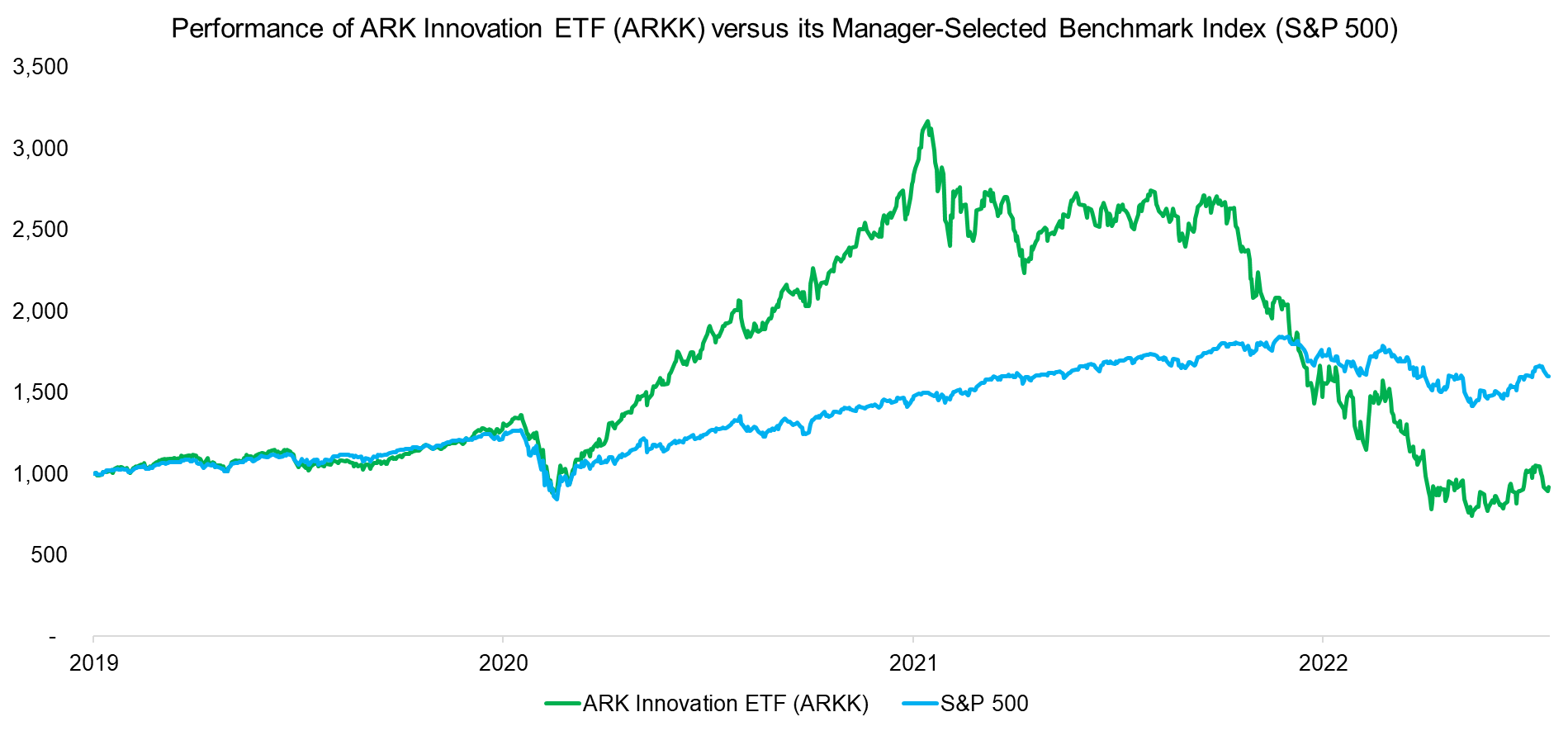
Source: FactorResearch
FACTOR EXPOSURE ANALYSIS OF ARKK
The significant difference in performance between ARKK and the S&P 500 over the last four years raises the question if the asset manager’s choice of benchmark is appropriate. ARKK consists of a highly concentrated portfolio of growth stocks like Tesla, while the S&P 500 is a diversified portfolio of companies from different sectors of the U.S. economy.
We run a factor exposure analysis to highlight the underlying drivers of ARKK’s performance, which shows a negative factor beta to the value, low volatility, and quality factors, as well as positive betas to momentum and size factors. Stated differently, the portfolio was comprised of expensive, highly volatile, outperforming small-cap companies with low-quality characteristics. Naturally, these exposures are substantially different from those of the constituents of the S&P 500 (read Factor Exposure Analysis 101: Linear vs Lasso Regression).
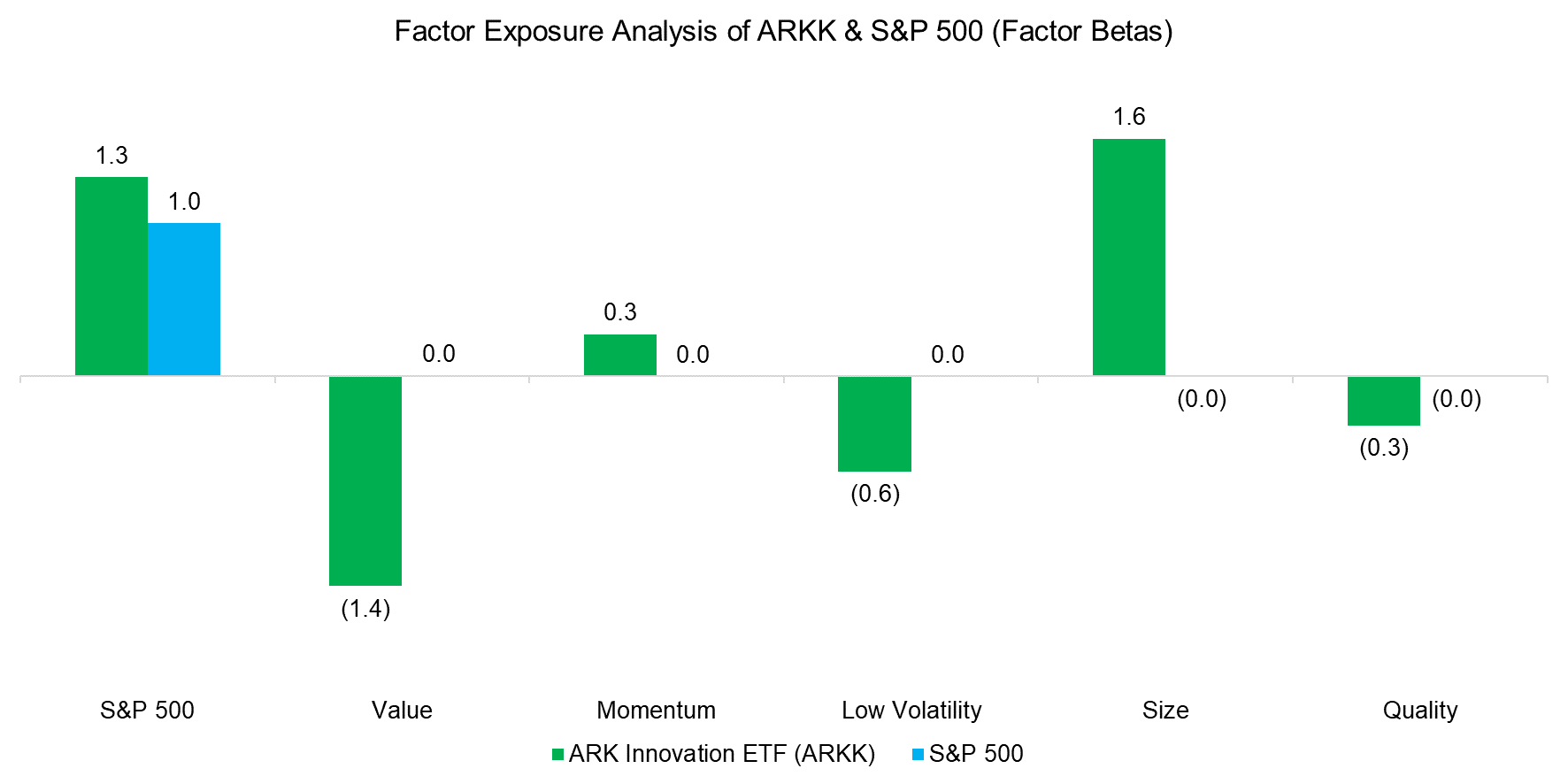
Source: FactorResearch
FACTOR-BASED BENCHMARK SELECTION
We can use a factor exposure analysis to systematically evaluate which benchmark is most appropriate for ARKK. There are more than 3 million indices, but only a few are recognized as benchmark indices by investors. S&P, Dow Jones, MSCI, and Russell indices dominate the world of benchmarks, at least in the equities space.
We select 40 well-known indices and calculate the betas to the market as well as five equity factors, namely value, size, momentum, quality, and low volatility for each of these indices. Next, we derive the sum of the absolute differences between the betas of the indices and ARKK. The index with the lowest sum should be the most appropriate benchmark as it matches ARKK most closely from a factor perspective.
Running this analysis confirms that the S&P 500 is a poor choice of benchmark and that is not even included in the top 10 of systematically chosen indices. The most appropriate benchmark is the Russell 2000 Growth Index. Given that ARKK has exposure to mid and small-cap growth stocks, this makes intuitive sense.
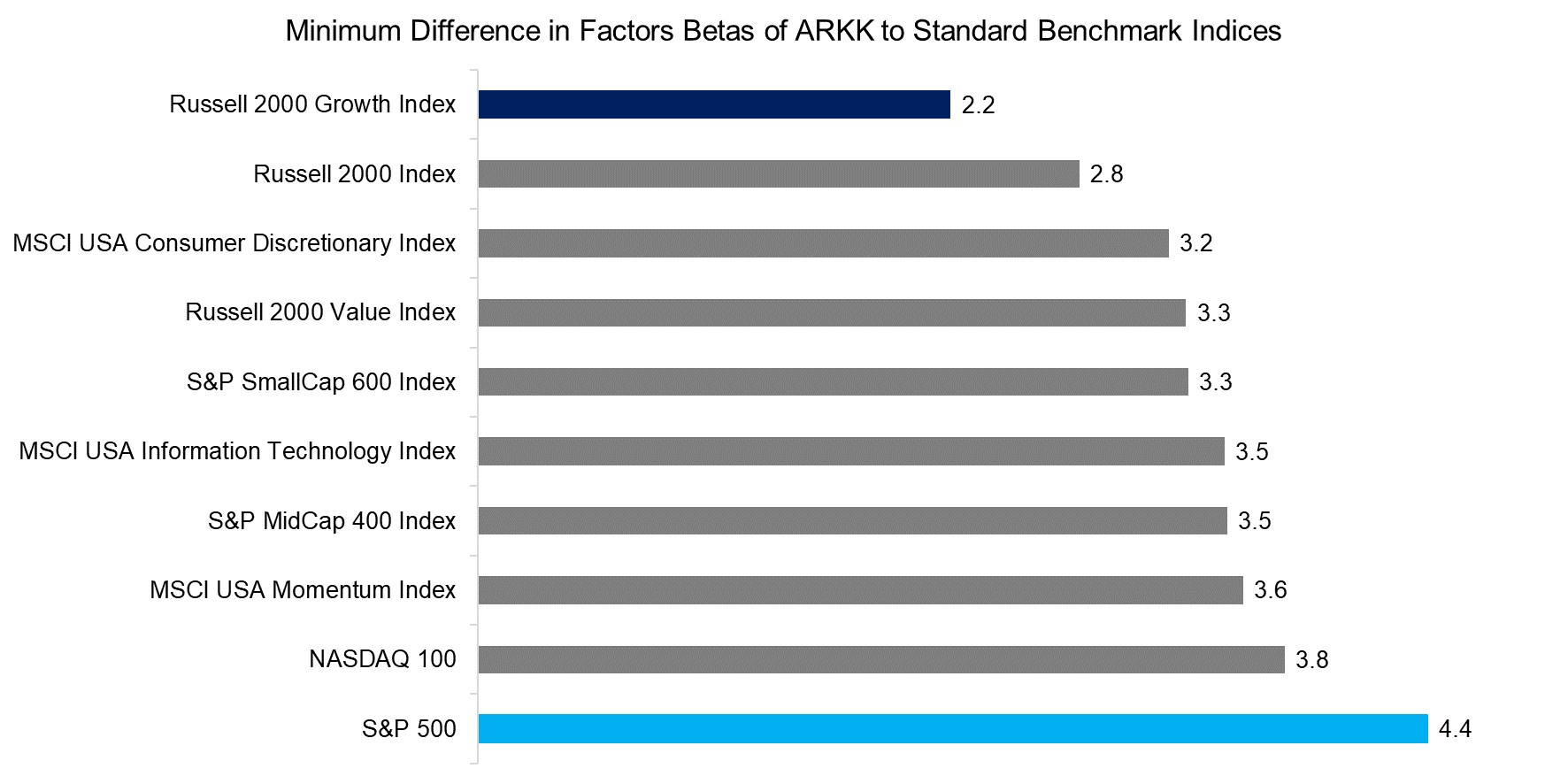
Source: FactorResearch
ADDITIONAL FACTOR EXPOSURE ANALYSIS
Although the Russell 2000 Growth is a better benchmark than the S&P 500 for ARKK, the factor exposures are not identical. ARKK and the Russell 2000 Growth Index both have negative exposures to the value and quality factors, and positive exposures to momentum and size. The exposure to the quality factor is of opposite sign, but marginal in magnitude.
However, the exposures should naturally not be identical. A benchmark index is supposed to reflect a similar investment style, but not represent a replication portfolio.
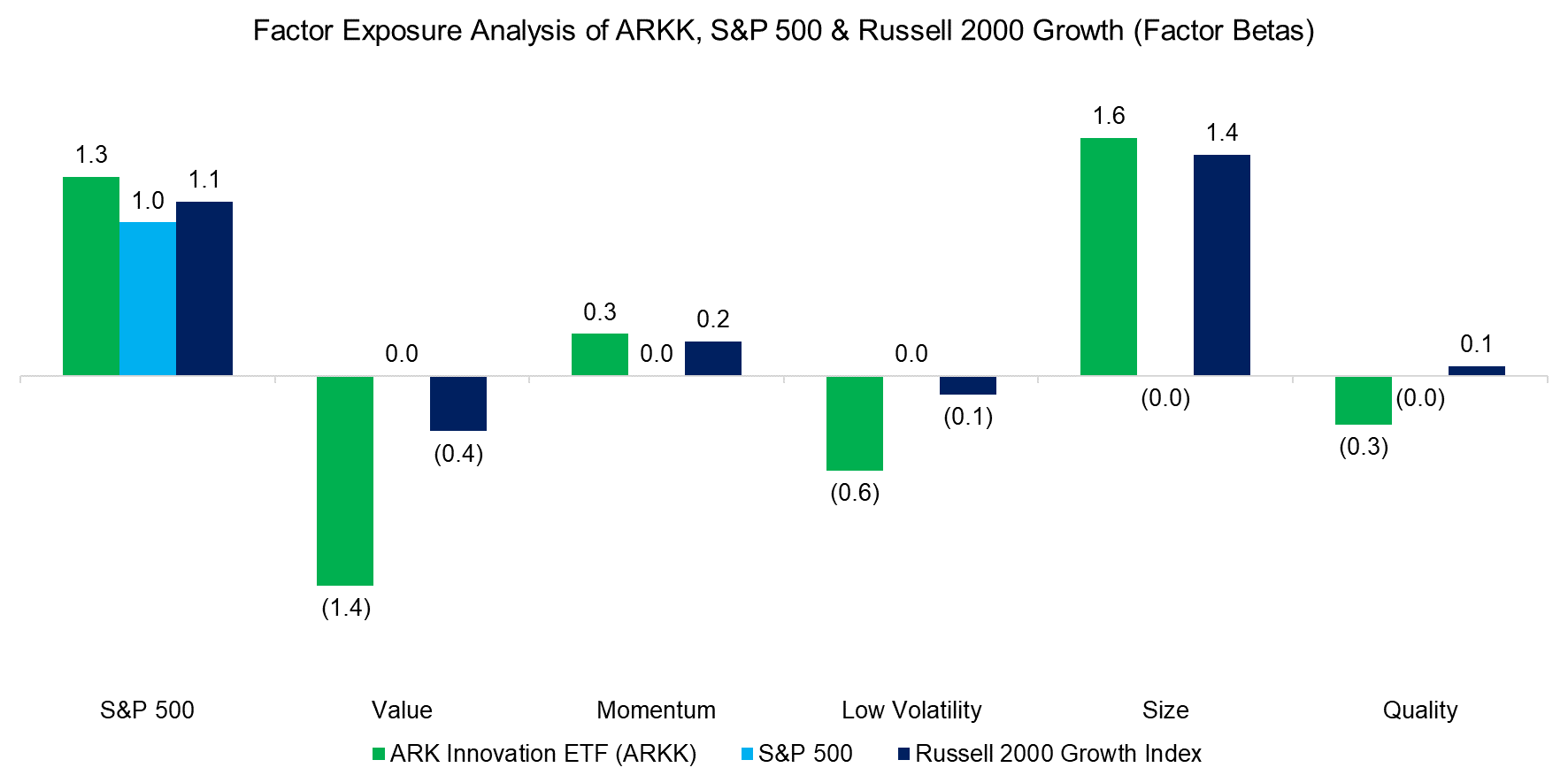
Source: FactorResearch
We can highlight the difference in benchmarks by contrasting the outperformance of ARKK to the manager-selected and factor-based benchmarks. In the period from 2019 to 2021, the difference to the benchmarks was relatively comparable, but thereafter the Russell 2000 Growth Index performed worse than the S&P 500 as growth stocks sold off, so the underperformance of ARKK was less negative.
Given this, ARKK would have been better off to show the Russell 2000 Growth Index rather than the S&P 500 as a benchmark in their factsheet. Although using the S&P 500 showed an impressive outperformance of ARKK in some years, which can be attributed to certain factor exposures, it backfired in other years like 2022 when the ETF’s factor combination performed poorly.
Knowing your factors is critical when evaluating funds.
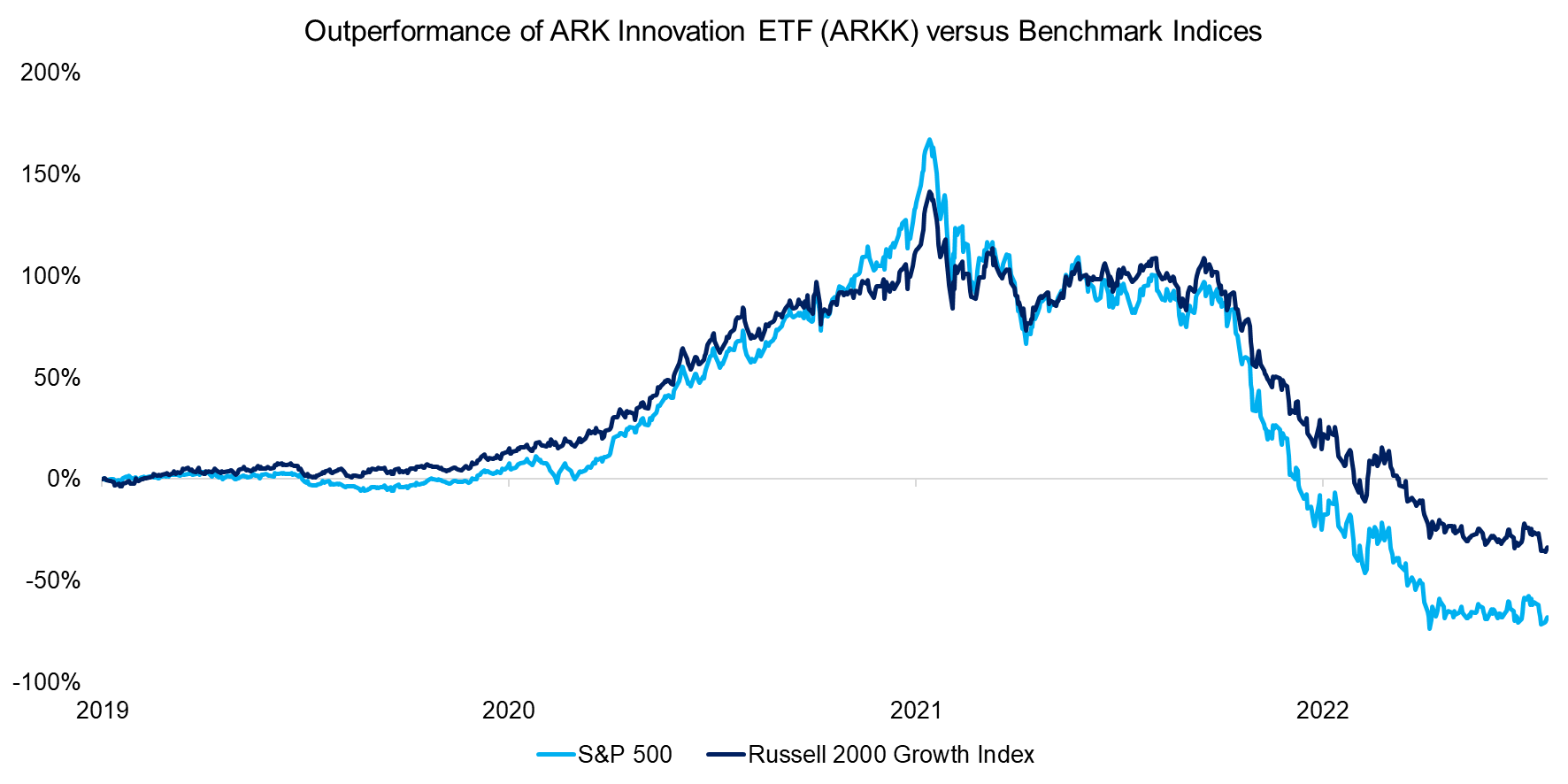
Source: FactorResearch
MANAGER VERSUS FACTOR-BASED BENCHMARK SELECTION
Finally, we randomly select 12 actively-managed U.S. mutual funds and ETFs where we contrast the outperformance to a benchmark index chosen by the asset manager versus the factor-based selection process.
We observe significant differences in outperformance in some products, but also identical results in a few of them like the Pear Tree Quality Fund (QGIAX) or State Street US Core Equity Fund (SSAQX). In these cases, the manager and factor-based benchmarks were identical.
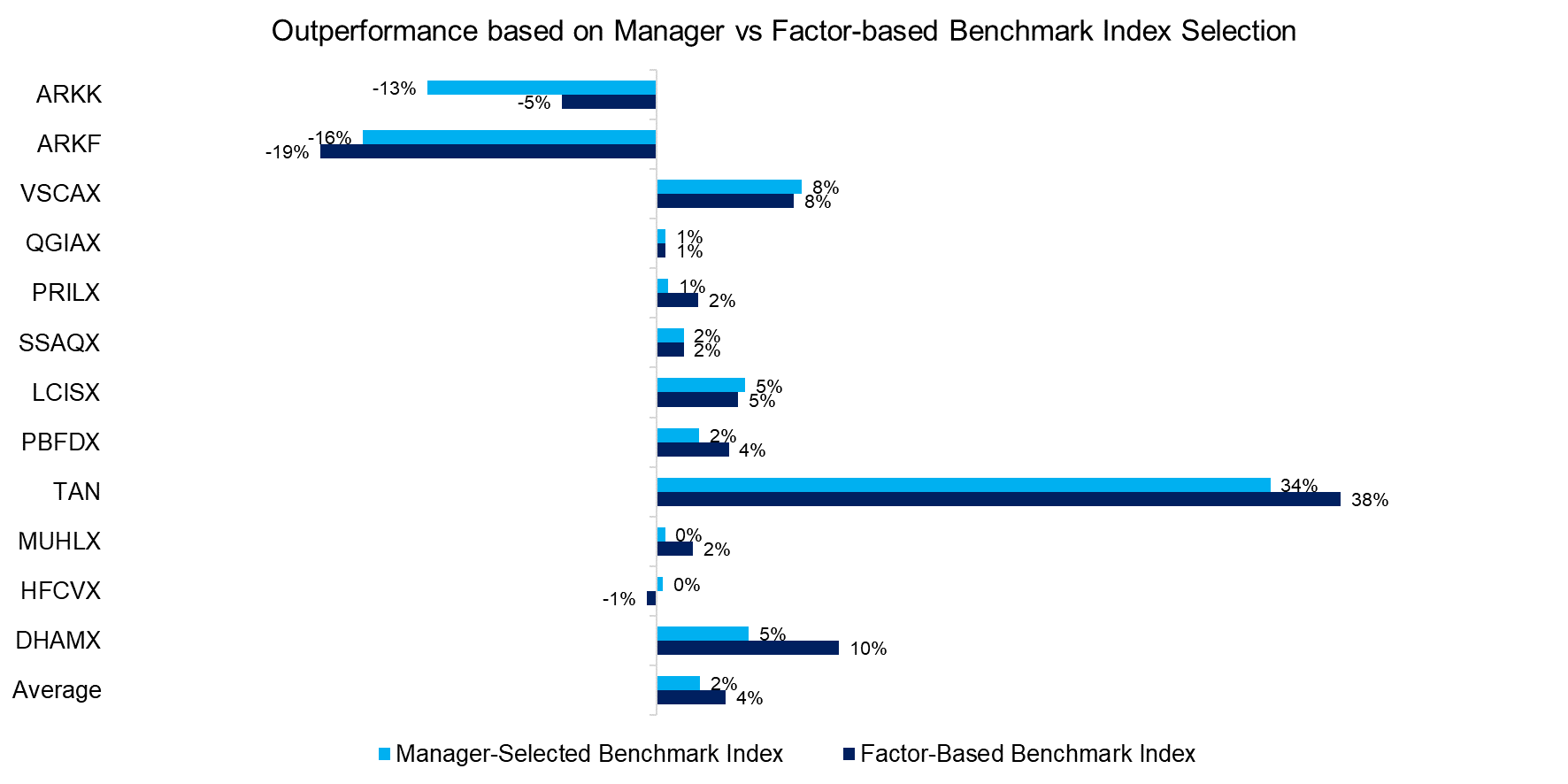
Source: FactorResearch
FURTHER THOUGHTS
The world of active management continues to evolve as assets are shifting from mutual funds to private asset classes and naturally ETFs. Benchmarking private funds is difficult given a lack of recognized indices for the various types of private equity, venture capital, and real estate strategies (read Benchmarking Smart Beta ETFs).
ETFs, intuitively, may not seem to require a benchmark, but that line of thought only applies to the original ones that track benchmarks like the S&P 500. There is no reason not to benchmark actively-managed, thematic, or smart beta ETFs, especially if it can be done systematically with relatively little effort.
RELATED RESEARCH
Outperformance Ain’t Alpha
Less Efficient Markets = Higher Alpha?
Smart Beta vs Alpha + Beta
Alpha Generation: The Search for the Unexplainable
Factor Exposure Analysis 103: Exploring Residualization
Time Machines for Investors
Factor Exposure Analysis 102: More or Less Independent Variables?
ABOUT THE AUTHOR
Nicolas Rabener is the CEO & Founder of Finominal, which empowers professional investors with data, technology, and research insights to improve their investment outcomes. Previously he created Jackdaw Capital, an award-winning quantitative hedge fund. Before that Nicolas worked at GIC and Citigroup in London and New York. Nicolas holds a Master of Finance from HHL Leipzig Graduate School of Management, is a CAIA charter holder, and enjoys endurance sports (Ironman & 100km Ultramarathon).
Connect with me on LinkedIn or X.

